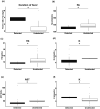Pediatric Respiratory Virus Infections During the COVID-19 Pandemic in a Region Without Active Severe Acute Respiratory Syndrome Coronavirus 2 (SARS-CoV-2) Circulation
- PMID: 36061581
- PMCID: PMC9419221
- DOI: 10.33160/yam.2022.08.011
Pediatric Respiratory Virus Infections During the COVID-19 Pandemic in a Region Without Active Severe Acute Respiratory Syndrome Coronavirus 2 (SARS-CoV-2) Circulation
Abstract
Background: Severe acute respiratory syndrome coronavirus 2 (SARS-CoV-2) infections were not prevalent in Yonago and its vicinity during autumn 2020, and the relative frequencies of pathogen-induced respiratory infections during this period are unclear.
Methods: We collected 109 nasopharyngeal swabs from 93 pediatric patients who visited Tottori University Hospital between October 1, 2020, and March 31, 2021. These samples were comprehensively tested for 18 pathogens with the FilmArray® respiratory panel test (v2.1) using nested real-time polymerase chain reaction, and the frequency of pathogens detected per month was calculated. In addition, we compared the duration of fever and the blood test results of patients infected with each pathogen or multiple pathogens.
Results: Of the 109 samples, 42 were obtained from female patients and 67 from male patients (median age, 3 years; range, 0-15 years). Overall, 62 patients (56.9%) had a fever ≥ 38 °C at the time of examination, and the median duration of fever ≥ 38 °C was 2 days (1-12). During the study period, the highest number of samples (22) were collected in November 2020. Among samples that tested positive, the most common pathogens were rhino/enteroviruses (52 samples; 76.5%), followed by adenoviruses (7 samples; 10.3%), coronavirus NL63 (6 samples; 8.8%), coronavirus OC43, parainfluenza virus type 1, and parainfluenza virus type 2 (1 sample each; 1.5% each). The duration of fever was significantly longer in adenovirus-infected patients than in patients infected with other viruses (P < 0.05). Hemoglobin and sodium levels were also significantly lower among the adenovirus-infected patients. However, these variations were mostly within the normal range. No clinically meaningful differences were found between rhino/enterovirus-infected and non-rhino/enterovirus-infected cases, between coronavirus NL63-infected and non-coronavirus NL63-infected cases, and between cases with multiple- and single-pathogen infections.
Conclusion: Rhino/enteroviruses were the most common viruses causing respiratory tract infections in areas without endemic SARS-CoV-2.
Keywords: adenovirus; common coronavirus; respiratory panel test; rhino/enterovirus; severe acute respiratory syndrome coronavirus 2.
©2022 Tottori University Medical Press.
Conflict of interest statement
The authors declare no conflict of interest.
Figures



Similar articles
-
Respiratory Virus Infections during the COVID-19 Pandemic Revealed by Multiplex PCR Testing in Japan.Microbiol Spectr. 2023 Feb 1;11(2):e0416222. doi: 10.1128/spectrum.04162-22. Online ahead of print. Microbiol Spectr. 2023. PMID: 36723071 Free PMC article.
-
Distribution of Viral Respiratory Infections during the COVID-19 Pandemic Using the FilmArray Respiratory Panel.Biomedicines. 2022 Oct 28;10(11):2734. doi: 10.3390/biomedicines10112734. Biomedicines. 2022. PMID: 36359254 Free PMC article.
-
Changing epidemiology of influenza and other respiratory viruses in the first year of COVID-19 pandemic.J Infect Public Health. 2021 Sep;14(9):1186-1190. doi: 10.1016/j.jiph.2021.08.004. Epub 2021 Aug 8. J Infect Public Health. 2021. PMID: 34399190
-
Effects of Non-Pharmacological Interventions on Respiratory Viruses Other Than SARS-CoV-2: Analysis of Laboratory Surveillance and Literature Review From 2018 to 2021.J Korean Med Sci. 2022 May 30;37(21):e172. doi: 10.3346/jkms.2022.37.e172. J Korean Med Sci. 2022. PMID: 35638198 Free PMC article. Review.
-
Human and novel coronavirus infections in children: a review.Paediatr Int Child Health. 2021 Feb;41(1):36-55. doi: 10.1080/20469047.2020.1781356. Epub 2020 Jun 25. Paediatr Int Child Health. 2021. PMID: 32584199 Review.
References
-
- Brendish NJ,Malachira AK,Clark TW. Molecular point-of-care testing for respiratory viruses versus routine clinical care in adults with acute respiratory illness presenting to secondary care: a pragmatic randomised controlled trial protocol (ResPOC). BMC Infect Dis. 2017;17:128. 10.1186/s12879-017-2219-x - DOI - PMC - PubMed

